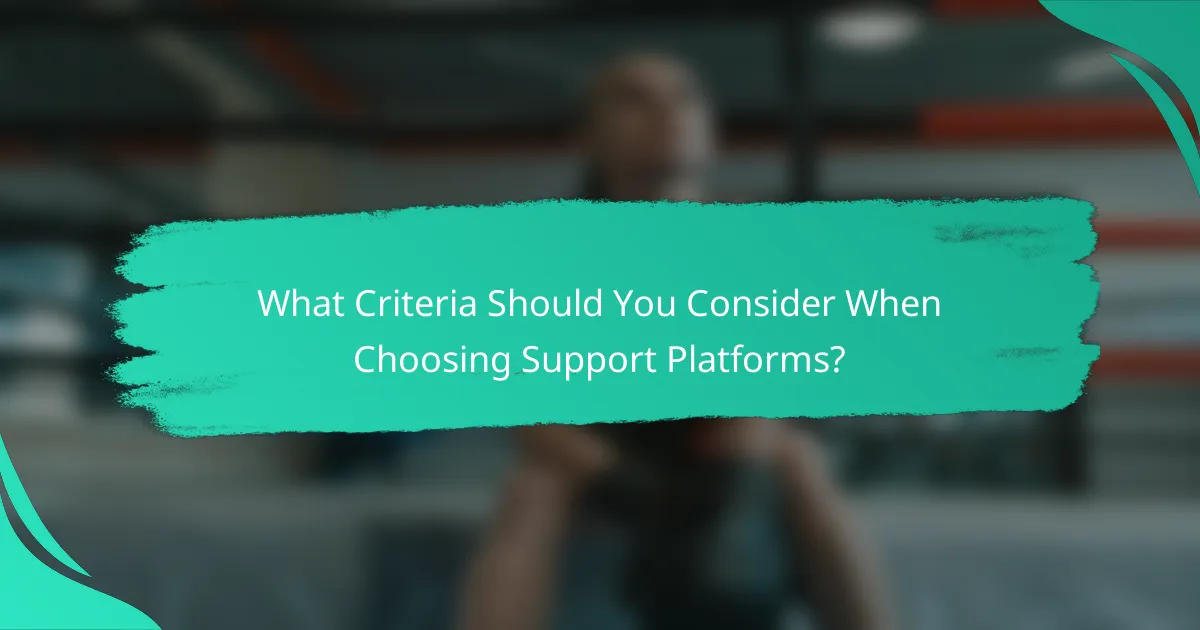Emotional support thrives within community bonds, where individuals connect over shared experiences and challenges. These relationships foster understanding and empathy, significantly enhancing mental well-being. Digital platforms further facilitate these connections, allowing people to build supportive networks and share their journeys, regardless of location.

How Can Community Bonds Improve Emotional Support?
Community bonds significantly enhance emotional support by fostering connections among individuals who share similar experiences and challenges. These relationships create a network of understanding and empathy, which can lead to improved mental well-being.
Increased feelings of belonging
Belonging to a community can alleviate feelings of isolation and loneliness. When individuals connect with others who share their experiences, they often feel more accepted and valued, which can boost their self-esteem and emotional health.
Participating in community activities, whether local clubs or online forums, can reinforce this sense of belonging. Engaging regularly with others helps solidify these connections and provides a support system during difficult times.
Enhanced coping mechanisms
Community bonds can provide effective coping strategies for dealing with stress and adversity. Sharing experiences with others allows individuals to learn from different approaches and solutions that have worked for their peers.
For instance, support groups often facilitate discussions about personal challenges, enabling members to exchange practical advice and emotional support. This collaborative environment can lead to improved coping skills and resilience in facing life’s difficulties.
Opportunities for shared experiences
Shared experiences within a community create a powerful sense of unity and understanding. Participating in group activities, such as workshops or social events, allows individuals to bond over common interests and challenges.
These shared moments can lead to lasting friendships and a deeper emotional connection, which is vital for mental well-being. Engaging in community service or group projects can further enhance these experiences, fostering teamwork and collaboration.
Access to diverse perspectives
Being part of a community exposes individuals to a variety of viewpoints and life experiences. This diversity can enrich one’s understanding of different emotional responses and coping strategies, broadening their emotional toolkit.
Listening to others’ stories can provide insights into alternative ways of handling similar situations, promoting empathy and compassion. This exchange of ideas can be particularly beneficial in multicultural communities, where varied backgrounds contribute to a richer support network.
Strengthened resilience
Community bonds can significantly bolster resilience by providing a safety net during challenging times. Knowing that support is available can empower individuals to face difficulties with greater confidence.
Engaging with a supportive community encourages individuals to share their struggles and successes, reinforcing the idea that they are not alone. This collective strength can be vital in overcoming obstacles and fostering a more resilient mindset.

What Digital Products Facilitate Peer Connections?
Digital products that facilitate peer connections include online support groups, social media platforms, mobile apps for mental health, and virtual workshops. These tools enable individuals to share experiences, seek advice, and build supportive networks regardless of geographical barriers.
Online support groups
Online support groups provide a safe space for individuals to connect over shared experiences and challenges. These groups often focus on specific issues, such as anxiety, depression, or grief, allowing members to share insights and coping strategies.
Participants can join forums or video calls, which can enhance the sense of community. Look for groups that are moderated to ensure a respectful and supportive environment.
Social media platforms
Social media platforms like Facebook and Instagram can foster peer connections through dedicated groups and communities. Users can join groups that align with their interests or struggles, allowing for interaction and support from peers.
While these platforms offer vast reach, it’s essential to engage mindfully. Be aware of the potential for misinformation and prioritize groups that promote positive and accurate discussions.
Mobile apps for mental health
Mobile apps designed for mental health often include features that connect users with peers. Apps like Meetup or 7 Cups provide opportunities for individuals to chat, share experiences, and receive support from others facing similar challenges.
When choosing an app, consider its user reviews and privacy policies. Look for apps that offer community guidelines to ensure a safe and supportive atmosphere.
Virtual workshops and webinars
Virtual workshops and webinars offer structured environments where individuals can learn and connect with others. These sessions often cover topics related to mental health, coping strategies, and personal development, encouraging interaction among participants.
To maximize the benefits, actively participate in discussions and networking opportunities during these events. Seek out workshops that allow for small group interactions to foster deeper connections.

How Do Shared Experiences Foster Emotional Support?
Shared experiences create a foundation for emotional support by allowing individuals to connect over common challenges and triumphs. These connections can lead to stronger community bonds, increased empathy, and a sense of belonging.
Building trust through storytelling
Storytelling is a powerful tool for building trust within a community. When individuals share their personal narratives, they reveal vulnerabilities and create an environment where others feel safe to do the same. This exchange fosters deeper connections and mutual understanding.
For example, support groups often encourage members to share their stories, which can help break down barriers and establish a sense of camaraderie. Over time, these shared stories can lead to lasting friendships and a supportive network.
Creating a sense of normalcy
Shared experiences can normalize feelings and behaviors that individuals may perceive as unique or isolating. When people realize that others face similar challenges, it alleviates feelings of loneliness and fosters acceptance.
For instance, discussing common struggles such as mental health issues or life transitions can help individuals feel that their experiences are valid and shared by others. This sense of normalcy can be particularly comforting in times of distress.
Encouraging vulnerability and openness
Encouraging vulnerability is essential for emotional support, as it allows individuals to express their true feelings without fear of judgment. When people witness others being open about their struggles, it creates a safe space for them to share their own experiences.
To promote this openness, communities can implement practices such as regular check-ins or sharing circles, where participants are invited to discuss their feelings and experiences. This approach not only strengthens bonds but also cultivates a culture of empathy and support.

What Criteria Should You Consider When Choosing Support Platforms?
When selecting support platforms, prioritize user privacy, accessibility features, and community guidelines. These factors ensure a safe, inclusive, and well-regulated environment for sharing experiences and building connections.
User privacy and security
User privacy and security are crucial when choosing a support platform. Look for platforms that offer end-to-end encryption and clear privacy policies detailing how your data is handled. Ensure that the platform allows you to control your personal information and choose what to share.
Consider platforms that comply with regulations such as GDPR in Europe or CCPA in California, which provide additional protections for user data. Always check for features like anonymous participation options to enhance your privacy.
Accessibility features
Accessibility features are essential for ensuring that all users can engage with the support platform effectively. Look for platforms that provide options such as text-to-speech, screen reader compatibility, and customizable font sizes. These features help accommodate users with various disabilities.
Additionally, consider platforms that offer multilingual support or easy navigation for individuals with different levels of tech proficiency. This inclusivity fosters a stronger community bond by allowing diverse participation.
Community guidelines and moderation
Community guidelines and moderation policies play a vital role in maintaining a safe and respectful environment. Review the platform’s rules regarding acceptable behavior and the consequences for violations. Strong guidelines help prevent harassment and ensure constructive interactions.
Effective moderation practices, such as active monitoring and user reporting systems, can significantly enhance the community experience. Look for platforms that have a transparent moderation process, allowing users to feel secure and supported in sharing their experiences.

What Are the Benefits of Peer Support Networks?
Peer support networks provide emotional and practical assistance through shared experiences, fostering a sense of belonging and understanding. These connections can lead to significant improvements in mental well-being and resilience.
Improved mental health outcomes
Peer support networks can lead to enhanced mental health outcomes by offering individuals a platform to share their experiences and feelings. This exchange can reduce feelings of isolation and increase feelings of acceptance and validation.
Engaging with peers who have faced similar challenges can provide practical coping strategies and emotional support. Participants often report lower levels of anxiety and depression, as well as increased self-esteem and empowerment.
To maximize benefits, individuals should seek out networks that align with their specific needs and experiences. Regular participation and open communication within these groups can further strengthen mental health improvements.
